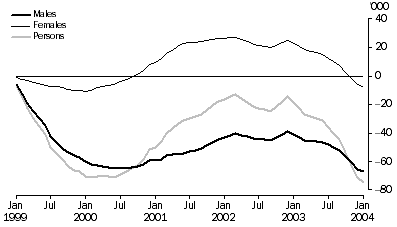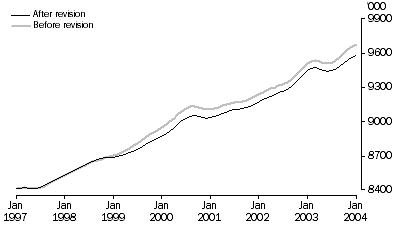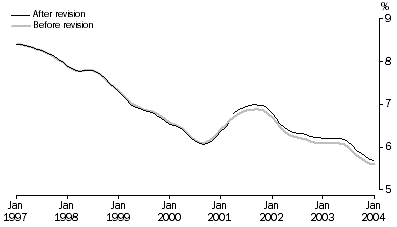Feature Article - Improvements to Labour Force estimates
This article was published in the April 2004 issue of Australian Labour Market Statistics (cat. no. 6105.0).
Introduction
The monthly Labour Force Survey (LFS) is one of the most important ABS labour collections, providing timely information on labour market activity within Australia. The statistics of most interest each month are estimates of the number of employed and unemployed, the unemployment rate and the labour force participation rate.
The LFS estimates released for February 2004 incorporated a number of changes to unit record data:
- implementation of revised population benchmarks
- introduction of regional population benchmarks
- revision of historical unit record data for definitional changes introduced with the new LFS questionnaire in April 2001
- implementation of a minor change to the definition of unemployment involving the treatment of future starters not actively looking for work, and
- a change to coding of industry and occupation.
All of these revisions flow through to published original series, and some flow through to seasonally adjusted and trend estimates.
Implementation of revised population benchmarks
LFS estimates of persons employed, unemployed and not in the labour force are calculated in such a way as to add up to independent estimates of the civilian population aged 15 and over (population benchmarks).
The benchmarks are based on Census of Population and Housing data, adjusted for differences in scope, under-enumeration in the Census, and updated monthly for births, deaths, interstate and intrastate migration, and net permanent and long-term overseas migration. Benchmarks are classified by state/territory of usual residence, part of state of usual residence (capital city/balance of state), age and sex. Each cross-classification of these benchmark variables is known as a benchmark cell.
Expansion factors, or weights, are applied to the survey's sampled respondents to derive estimates that relate to the whole population in the scope of the survey each month. Each sample respondent is allocated a weight depending on their benchmark cell and state/territory of enumeration.
LFS estimates for each characteristic of interest are formed by summing the weights of the respondents in the sample with that characteristic. The weighting procedure reduces sampling variability by ensuring that estimates conform to the benchmark distribution of the usually resident civilian population by age, sex and geographic area, while simultaneously compensating and adjusting for any under-enumeration or non-response in the survey.
Every five years, LFS estimates are revised when updated benchmarks become available from the Census of Population and Housing. From February 2004, LFS estimates are being compiled using revised population benchmarks based on results from the 2001 census. LFS estimates for the period January 1999 to January 2004 have been revised based on the updated population benchmarks.
Data prior to January 1999 were not revised because the effects on survey estimates were too small to warrant revision.
The civilian population aged 15 years and over has been revised downward, by no more than 0.5% in any month, for the period January 1999 to January 2004. The largest revision to the civilian population (-74,800) was in January 2004, as shown in the following graph.
Benchmark revisions by sex

Male population benchmarks have been revised downward for the entire period (to a maximum of 0.9%), the largest revision being -67,100 in January 2004. In contrast, female population benchmarks have been predominantly revised upward (to a maximum of 0.3%), with the largest revision being +27,400 in March 2002.
Changes to civilian population benchmarks are not uniform across age groups. Benchmarks for age groups in the 20-29 year range have decreased significantly, with the largest decrease being 162,800 in January 2004. People in the 20-29 year age group have relatively high labour force participation rates. Benchmarks for older age groups have generally increased, but these increases only partly offset the falls in the younger age groups. The largest increase in the older age groups is for persons aged 65 years and over, an age group with a very low labour force participation rate.
As a result of the benchmark changes, over the period January 1999 to January 2004:
- employed persons have been revised down by an average of 66,300
- unemployed persons have been revised down by an average of 8,100
- the unemployment rate has been revised down by an average of 0.03 percentage points, and
- the participation rate has been revised down by an average of 0.32 percentage points.
Unemployed persons, the unemployment rate, and the participation rate are also affected by the definitional change involving future starters. See the relevant section below.
Because of age compositional effects, the downward revision to employment estimates is larger than the downward revision to the civilian population, with the largest revision being -100,200 for the January 2004 estimate. The graph below compares trend estimates for the period January 1999 to January 2004 before and after the revisions.
Employed persons

Regional population benchmarks
While the LFS is designed primarily to produce reliable estimates at the national, state and territory levels, it also delivers estimates for employed persons and unemployed persons for a number of regions (Labour Force Statistical Regions) within states.
Prior to February 2004, population benchmarks in the LFS were classified by state/territory of usual residence, capital city/rest of state, age and sex. In addition to these, LFS data from February 2004 use population benchmarks for labour force region by sex.
Historically, estimates at the regional level have shown a high degree of variability relative to state and part of state estimates. This is because regional estimates are subject to larger impacts of sampling variability, in that the weighted estimates reflect both the distribution of the sample selected (and not an independent population benchmark) and the characteristics of the sample selected. The larger impact of sampling variability leads to larger month to month variation and higher standard errors for these regional estimates.
Implementing population benchmarks for statistical regions reduce the variability of regional estimates, without compromising the quality of estimates at national, state and territory levels. However, the variability inherent in having a relatively small sample at the regional level will remain.
LFS estimates at the regional level have been revised based on population benchmarks for Labour Force Statistical Regions for the period January 1999 to January 2004.
April 2001 definitional changes
In April 2001, the ABS revised historical estimates for core labour force series resulting from two definitional changes made during the introduction of the new LFS questionnaire. The two definitional changes made were:
- people on short-term unpaid leave initiated by the employer (that is, people stood down for less than four weeks without pay) were classified as employed rather than as unemployed
- people who were unavailable to start work in the reference week due to temporary illness were classified as not in the labour force rather than as unemployed.
While core labour force series were revised in 2001 for these two definitional changes, the revisions were not made at the unit record level. This meant that other aggregates produced from unit record data did not reconcile with the core series that were directly revised.
In February 2004, unit record data were revised for these definitional changes. Core series that were revised in April 2001 were not affected by this change.
For more information on these definitional changes refer to Information Paper: Implementing the Redesigned Labour Force Survey Questionnaire (cat. no. 6295.0).
Definitional change for future starters
In February 2004, the ABS introduced a minor change to the definition of unemployed persons. The change relates to a small group of persons ('future starters') who had not actively looked for work because they were waiting to start a new job within four weeks from the end of the survey reference week, and could have started in the reference week if the job had been available then. Prior to February 2004, these persons were classified as not in the labour force. They have now been classified as unemployed, in line with International Labour Organisation guidelines.
Data to support this change has been available since the new LFS questionnaire was introduced in April 2001. However, the ABS announced at the time that, due to concerns that such a change could result in a break in some core labour force series, implementation of the change would be deferred until February 2004. LFS estimates have been revised back to April 2001 to reflect this change. Around 15,000 persons per month (on average) have been reclassified from not in the labour force to unemployed. This revision creates a small trend break at April 2001 in unemployed persons and unemployment rate series.
The effect of the definitional change on the unemployment rate is to revise it upwards by an average of 0.15 percentage points over the period from April 2001. When combined with the downward effects of the revised population benchmarks, the unemployment rate has been revised upwards over this period by an average of 0.11 percentage points. The graph below compares trend estimates of the unemployment rate for the period January 1999 to January 2004 before and after both sets of revisions.
Unemployment rate

The effect of the definitional change on the participation rate is to revise it upwards by an average of 0.10 percentage points over the period from April 2001. When combined with the downward effects of the revised population benchmarks, the participation rate has been revised downwards over this period by an average of 0.27 percentage points.
Change to coding of industry and occupation
Every three months, respondents to the LFS who are employed or unemployed are asked a series of questions which are used to code industry and occupation. In a small number of cases, responses to these questions are not sufficiently detailed to allow the ABS to code people to the lowest level of these classifications. Since the introduction of computer assisted coding in 2000, these responses had been proportionally distributed to the most detailed level of the classifications.
From February 2004, these insufficiently detailed responses have been coded to 'not further defined' categories at an appropriate level in both the industry and occupation classifications.
Industry and occupation series have been revised back to August 2000 to include these 'not further defined' categories. Industry estimates at the Division (1-digit) level and occupation estimates at the Major Group (1-digit) level are unchanged.
Tables in Information Paper: Forthcoming Changes to Labour Force Statistics (cat. no. 6292.0) demonstrate the impact that this change had on the May 2003 industry estimates at the Subdivision (2-digit) level, and occupation estimates at the Sub-Major Group (2-digit) level.
Further information
The first estimates incorporating the revisions to LFS unit record data described in this paper were released with the February 2004 issue of Labour Force, Australia (cat. no. 6202.0), released on 11 March 2004. Electronic products (cat. no. 6202.0.55.001) associated with that publication also contained revised data.
In addition, more detailed products associated with the second release of LFS data (cat. no. 6291.0.55.001) were re-issued on 11 March 2004 containing revised data up to, and including, January 2004. Second release products, including February 2004 estimates, were released on 18 March 2004, in accordance with the standard timetable.
For further information about the implementation of any of these changes, contact Peter Bradbury on Canberra 02 6252 6565, or via email on peter.bradbury@abs.gov.au.
 Print Page
Print Page
 Print All
Print All